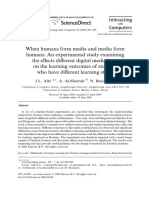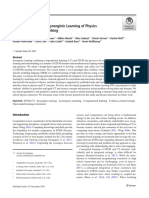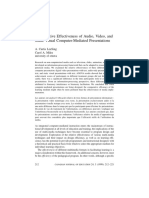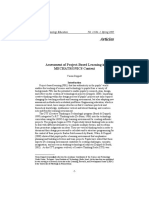Paper Kordaki PDF
Paper Kordaki PDF
Uploaded by
Zisis CharalCopyright:
Available Formats
Paper Kordaki PDF
Paper Kordaki PDF
Uploaded by
Zisis CharalOriginal Title
Copyright
Available Formats
Share this document
Did you find this document useful?
Is this content inappropriate?
Copyright:
Available Formats
Paper Kordaki PDF
Paper Kordaki PDF
Uploaded by
Zisis CharalCopyright:
Available Formats
IADIS International Conference on Cognition and Exploratory Learning in Digital Age (CELDA 2008)
METAPHOR-BASED EDUCATIONAL SOFTWARE FOR
BEGINNERS LEARNING OF OPERATING SYSTEMS
Maria Kordaki*
Adjunct Assistant Professor
Department of Computer Engineering and Informatics, Patras University, 26500, Rion Patras, Greece
George Strimpakos*
Prospective Computer Engineer
Zisis Charalampidis*
Prospective Computer Engineer
Thanasis Daradoumis**
Associate professor
Department of Computer Sciences, Open University of Catalonia, Rambla Poblenou 156, 08018 Barcelona, Spain
**
ABSTRACT
This paper presents the design of educational software for beginners learning of basic concepts of Operating Systems
(OS). The design of the proposed educational software is based on modern social and constructivist learning theories as
well as on the essential role of metaphors and of computer tools in student learning. In particular, the architecture of the
proposed software consists of two main parts: a) the information space where students are provided with opportunities to
access appropriate information about OS and to study scheduling, using a simple and fundamental algorithm; the Priority
Round-Robin (PRR) algorithm, and b) the experimentation space where learners can take control of their learning by
forming their own set of tasks, assigning them priorities and durations and also scheduling them using the PRR
algorithm. Finally, the proposed system has been designed so that to provide pupils with feedback so that they may make
self corrections.
KEYWORDS
Educational software, Operating Systems, Secondary Education.
1. INTRODUCTION
Understanding and advocating of Computer Science (CS) as an essential component of a well-rounded
education is a key factor in ensuring that young students have the skills needed, not just to survive, but to
thrive in this increasingly technological and global society. To this end, a four-level model curriculum of CS
for K-12 has been proposed (ACM, 2003). For the achievement of the goals of this curriculum, the
introduction of young students to the concept of an OS is critical. At this point, it is worth noting that, various
studies have reported the significance of the use of metaphors in the learning of concepts within the complex
domain of CS (Carrol & Tomas, 1982; Carrol and Mack, 1999; Hsu, 2006; Borgman, 1999; Cameron, 2002).
A metaphor is a kind of linguistic figure with the form X is Y consisting of two major parts (Carrol and
Mack, 1999). These major parts include novel concepts (X = target domain), previously acquired knowledge
(Y = base domain), and the relationship between the two (Wozny, 1989). The significant role of metaphors is
based on the fact that - when they are used - the critical role of students prior knowledge in acquiring new
knowledge is acknowledged as well as the essential role of engaging learners in real life problems (Lakoff &
Johnson, 1980; Ortony, 1979). In the context of metaphors, learners can also form more comprehensive
mental models, which results in better performance when they carry out complex tasks (Hsu, 2006).
325
ISBN: 978-972-8924-69-0 2008 IADIS
Appropriately designed computer-based learning environments can play a crucial role in student learning
(Noss and Hoyles, 1996; Jonassen, 1999). In fact, computers are an ideal medium for providing unique
opportunities for the design of learning situations within the framework of modern social and constructivist
theories of learning (Jonassen, 1999). To this end, students could become actively engaged in their learning
and also receive appropriate feedback (Hummel, 2006). In addition, computers can provide wide
opportunities for the construction of appropriately designed metaphors for the learning of complex concepts.
Here, it is worth noting that, the importance of using educational software in teaching OS courses is clearly
depicted in surveys conducted by (Davoli & Goldweber, 2003; Anderson & Nguyen, 2005). Several attempts
have also been made to build general-purpose computer system simulators that allow undergraduate students
to undergo an innovative and pedagogically different experience of learning OS (Morsiani & Davoli, 1999;
Goldweber, et. al, 2005; Holland, et. al., 2002; Hovemeyer, et. al., 2004). More recent work has contributed
in creating instructional simulators with a high degree of performance realism and simplicity (DeRosa, et. al.,
2006; Dobrilovic & Stojanov, 2006; Liu, et. al., 2007; Laverell, et. al., 2008). Despite the above, educational
software for the learning of basic aspects of OS by secondary level education students through the use of
metaphors has not yet been reported. In the following sections of this paper, the design and the features of the
proposed software are described. Finally, conclusions and proposals for future research are drawn.
2. DESIGN OF THE PROPOSED SOFTWARE: THE RATIONALE
In the design of the proposed educational software, socio-cultural and constructivist perspectives on
knowledge construction (Jonassen, 1999; Vygotsky, 1974) were taken into account. The role of tools and of
digital media and learning environments as mediators for the development of students higher mental
functions has been also acknowledged (Vygotsky, 1974; Noss & Hoyles, 1996). In the context of
constructivist learning, the role of exploiting a students prior knowledge is very important in facilitating his
or her learning of new concepts. To this end, the role of metaphors as mediators of students previous
knowledge in the construction of a knowledge representation for some knowledge domain has been
acknowledged (Carrol and Mack, 1999). Metaphors can have the form of kernel comparison statements
whose primary function in learning is to stimulate active learner-initiated thought processes. Metaphors are
open-ended because open-ended comparisons stimulate these processes more than explicit and
comprehensive comparisons do. Metaphors are also incomplete, but claiming to be powerful because of both;
the similarities and differences between the target and the source domain (Dubinsky & Hazzan, 2003). The
success of a metaphor depends on having a familiar domain to analogize from and on recognizing enough in
the new domain for some correspondence to be established (Gentner, 1983). In fact, a metaphor X is Y can
facilitate active learning by providing them with opportunities to generate and test various hypotheses about
the target novel domain (X) based on the similarities and dissimilarities it has with the base domain (Y). To
this end, metaphors can be used as orienting frameworks, at the same time leaving many operational details
for the learner to discover. Metaphors used cannot be too complex but have to be carefully crafted and
presented in such a way as to help learners to form comprehensive and appropriate connections between the
metaphor and critical points of the new knowledge. The use of more than one metaphor is also appropriate
for the learning of a novel concept. It can also become a principal learning process, when students are
encouraged to be involved in a process of generating their own metaphors regarding a novel learning subject
(Carrol and Mack, 1999).
Taking into account all the above, we propose the design of an interactive metaphor-based computer
environment for beginners learning of basic concepts related to an OS. Specifically, the emphasis is put on
the understanding by students of the most important missions of an OS, which are the management of all the
resources that constitute the configuration of a modern computer system and which coordinate the access
any user activity will have on them (Tanenbaum, 2001; http://en.wikipedia.org/wiki/Operating_system).
Scheduling is a key concept in computer multitasking and multiprocessing operating system design, as well
as in real-time OS design (Tanenbaum, 2001; http://en.wikipedia.org/wiki/Scheduling_(computing)). It refers
to the way processes are assigned priorities in a priority queue. This assignment is carried out by software
known as a scheduler. Among the plethora of common scheduling practices and disciplines, the Priority
Round-Robin Scheduling algorithm is one of the oldest, simplest, fairest and most widely used scheduling
algorithms designed especially for time-sharing systems (Faisstnauer, Schmalstieg, Purgathofer, 2000). Thus,
we decided to design an emulation of Priority Round-Robin (PRR) algorithm (Faisstnauer, Schmalstieg,
326
IADIS International Conference on Cognition and Exploratory Learning in Digital Age (CELDA 2008)
Purgathofer, 2000) in order for students to understand how scheduling works. The PRR algorithm was
chosen because of its simplicity but it was preferred to the classic RR algorithm because the latter was too
simple.
3. DESCRIPTION OF THE PROPOSED EDUCATIONAL SOFTWARE
The proposed software will be organized in HTML pages, with its features being presented on its main page,
and classified into two parts: i) information, and ii) experimentation space.
3.1 Information
The information space has been designed to provide three type of information: a) general information - in the
form of text - about basic aspects related to OS, such as task management, scheduling and the notion of time
quantum as well as a simple description of the PRR algorithm, b) appropriate URLs for further study, and c)
metaphoric ready examples of task scheduling using a specific time quantum and the PRR algorithm. The
metaphor examples used have to be selected in order to be simple and familiar to the students. To this end,
the set of tasks to be scheduled have to stem from students everyday life; thus, they will have the
opportunity to easily grasp the concept of task scheduling using priorities. In addition, students will have the
opportunity to give meaning to the concept of time quantum, as it will be far greater than those actually used
by a real OS. By exploring these metaphor examples, students also will have the chance to estimate
similarities and dissimilarities between these metaphoric examples and real OS. In this way, students can
acquire a deeper understanding of the basic concepts of OS and of PRR algorithm.
3.2 Experimentation Space
Within the experimentation space, students can learn about the previously mentioned concepts by taking an
active role designing their own metaphor examples. In fact, students have to be provided with the following
possibilities: a) to define a time quantum that they can select from a list and b) to define their own scenario of
tasks (for example 10 tasks) and to assign them with the priorities they prefer. Students also will have the
chance to define the duration of each task in terms of the time quantum they selected in the previously
mentioned step, c) to schedule the set of tasks according to their own conception of PRR algorithm, and d) to
receive feedback from the system in terms of automatically scheduling the said set of tasks using the PRR
algorithm. Appropriate help have to be also provided for the students to easily perform all the related
operations provided by the software. By forming their own metaphors, students can be active and also take
control of their learning. Students can also focus on the previously mentioned critical concepts related to OS
and the PRR algorithm. Students can also generate more than one metaphorical context of tasks so that they
can clarify these critical concepts. Then, students can further discuss and hypothesize about similarities and
dissimilarities of the task scheduling in this metaphorical open-ended context and the context of the real OS
and the PRR algorithm. In this sense, the metaphorical contexts formed can act as orienting frameworks
leaving many other details for the students to explore with their teachers in the discussion sections.
Moreover, by forming their own familiar domain to analogize from and on recognizing enough in the new
domain of OS using PRR, students are expected to be able to establish some correspondences.
4. EPILOGUE AND FUTURE PLANS
The design of interactive metaphor-based educational software for the learning of basic concepts of an
Operating System by beginners has been presented in this paper. In the context of this software, students will
have the chance to learn about some critical concepts related to OS, such as task scheduling, task priorities
and time quantum, using a simulation of the Priority Round-Robin algorithm. In the context of this proposed
educational software, students can experience enjoyment and pleasure by forming their own task scenarios
and assigning them both priorities and durations as well as scheduling them and receiving feedback by the
system. It is also expected that students will try interacting with the proposed software a number of times to
327
ISBN: 978-972-8924-69-0 2008 IADIS
reflect and make clarifications and abstractions about basic aspects of OS and the PRR algorithm. To verify
our expectations, the implementation of the proposed software well as the performance of field studies to
assess its impact on the learning of real students are in our future plans.
REFERENCES
Association for Computing Machinery, 2003. A Model Curriculum for K-12 Computer Science: Final Report of the ACM
K-12 Task Force Curriculum Committee. Last retrieved on 20/05/08 from http://www.acm.org/education/
curric_vols/k12final1022.pdf?searchterm=K-12
Borgman, C.L., 1999. The users mental model of an information retrieval system: an experiment on a prototype online
catalog. In International Journal of Human-Computer Studies, 51, pp. 435452.
Cameron, L., 2002. Metaphors in the learning of science: A discourse focus. In British Educational Research Journal, 28
(5), pp. 673688.
Carroll, J.M., Thomas, J.C., 1982. Metaphor and the cognitive representation of computing systems. In IEEE
Transactions on Systems, Man, and Cybernetics, SMC 12 (2), pp. 107116.
Carroll, J.M. and Mack, R.L., 1999. Metaphor, computing systems, and active learning. In International Journal of
Human-Computer Studies, 51, pp. 385403.
Anderson, C. & Nguyen, M., 2005. A survey of contemporary instructional operating systems for use in undergraduate
courses, Journal of Computing Sciences in Colleges, v.21 n.1, p.183-190.
Davoli, R. & Goldweber, M., 2003. New Directions in Operating Systems Courses Using Hardware Simulators,
ICSEE'03, SCS 2003.
DeRosa, P., Shen, K., Stewart, C., and Pearson, P., 2006. Realism and simplicity: disk simulation for instructional OS
performance evaluation, ACM SIGCSE Bulletin, v.38 n.1, March 2006.
Dobrilovic, D & Stojanov, Z., 2006. Using Virtualization Software in Operating Systems Course. In Proceedings of the
International Conference on Information Technology: Research and Education, 16-19 Oct. 2006, pp. 222 226.
Dubinsky, Y. & Hazzan, O., 2003. Using Metaphors in eXtreme Programming Projects. In M. Marchesi & G. Succi
(eds.) XP 2003. Springer-Verlag, Berlin Heidelberg, pp. 420-421.
Faisstnauer C., Schmalstieg D., Purgathofer W., 2000. "Priority round-robin scheduling for very large virtual
environments". Proceedings of the IEEE Virtual Reality 2000 Conference, Washington, DC, USA, pp. 135.
Gentner, D., 1983. Structure-mapping: A theoretical framework for analogy. In Cognitive Science. 7 (2), pp.155-170.
Goldweber, M., Davoli, R., and Morsiani, M., 2005. The Kaya OS project and the MPS hardware emulator. In
Proceedings of the 10th annual SIGCSE conference on Innovation and technology in computer science education,
Caparica, Portugal, pp. 49-53.
Jonassen, D. ., 1999. Designing constructivist learning environments. In Instructional design theories and models, 2,
pp. 215-239.
Holland, D., Lim, A., and Seltzer M., 2002. A new instructional operating system. In Proceedings of the ACM 33rd
Technical Symposium on Computer Science Education SIGCSE 2002, pp. 111-115.
Hovemeyer, D., Hollingsworth, J. and Bobby Bhattacharjee, B., 2004. Running on the bare metal with GeekOS,
Proceedings of the 35th SIGCSE technical symposium on CS education, March 03-07, 2004, Norfolk, Virginia, USA.
Hsu, Y.-C., 2006. The effects of metaphors on novice and expert learners performance and mental-model development,
In Interacting with Computers, 18 (2006), pp. 770792.
Hummel, H., G-K., 2006. Feedback Model to Support Designers of Blended-Learning Courses. In International Review
of Research in Open and Distance Learning, 7(3), pp. 1-16.
Lakoff, and Johnson, M. 1980. Metaphors we live by. Chicago University Press, Chicago, USA.
Laverell, W., Fei, Z., and Griffioen , J., 2008. Isn't it time you had an emulab? In Proceedings of the 39th SIGCSE
technical symposium on Computer Science Education, Portland, OR, USA, pp. 246-250.
Liu, H., Chen, X. and Gong, Y., 2007. BabyOS: a fresh start, ACM SIGCSE Bulletin, v.39 n.1, March 2007.
Morsiani, M. & Davoli R., 1999. Learning operating systems structure and implementation through the MPS computer
system simulator. ACM SIGCSE Bulletin archive, Vol. 31, Issue 1, pp. 63 67.
Noss, R. & Hoyles, C., 1996. Windows on mathematical meanings: Learning Cultures and Computers. Dordrecht:
Kluwer Academic Publishers.
Ortony, A., 1979. Metaphor and Thought. Cambridge University Press, Cambridge.
Tanenbaum, A.S., 2001. Modern Operating Systems (2nd Edition). Prentice Hall, NJ, USA.
Vygotsky, L., 1974. Mind in society. Cambridge, MA: Harvard University Press.
Wozny, L.A., 1989. The application of metaphor, analogy and conceptual models in computer systems. Interacting with
Computers, 1 (3), pp. 273283.
328
You might also like
- Burger 1992Document21 pagesBurger 1992Iraldy FashaNo ratings yet
- A Literature Review On: An Exploration of Internet Programming Technologies For LearningDocument14 pagesA Literature Review On: An Exploration of Internet Programming Technologies For LearningMalkeet SinghNo ratings yet
- Expert Concept Mapping Method For Definingthe Characteristics of Adaptive E-Learning:ALFANET Project CaseirschnerDocument16 pagesExpert Concept Mapping Method For Definingthe Characteristics of Adaptive E-Learning:ALFANET Project CaseirschnerSlaviStoyanovNo ratings yet
- Facktor Influence KnowledgeDocument7 pagesFacktor Influence KnowledgeGregory Wiro SekaiNo ratings yet
- The Role of Technology in Teaching and Learning Statistics: Dave Pratt, Neville Davies, and Doreen ConnorDocument11 pagesThe Role of Technology in Teaching and Learning Statistics: Dave Pratt, Neville Davies, and Doreen ConnorBernardo SilvaNo ratings yet
- Metaverse System Adoption in Education: A Systematic Literature ReviewDocument45 pagesMetaverse System Adoption in Education: A Systematic Literature ReviewDhrumil ModiNo ratings yet
- The Role of Visualization in Computer Science EducationDocument31 pagesThe Role of Visualization in Computer Science EducationSaksham SrivastavaNo ratings yet
- Applying A Constructivist and Collaborat PDFDocument25 pagesApplying A Constructivist and Collaborat PDFhectorjazzNo ratings yet
- The Effects of Varied Animation in Multimedia Learning: Is The Extra Effort Worthy?Document9 pagesThe Effects of Varied Animation in Multimedia Learning: Is The Extra Effort Worthy?IJDIWCNo ratings yet
- Student Modeling and Machine LearningDocument32 pagesStudent Modeling and Machine LearningCarstene RenggaNo ratings yet
- Alty2006 PDFDocument19 pagesAlty2006 PDFZaenal MutaqinNo ratings yet
- Marcelo C. BorbaZDM2009Document13 pagesMarcelo C. BorbaZDM2009Celia FasceNo ratings yet
- Perceived Openness of Learning ManagemenDocument10 pagesPerceived Openness of Learning Managemennandaas887No ratings yet
- Mobile Moodle at AUDocument7 pagesMobile Moodle at AUSiti Ismawaty Sheikh IsmailNo ratings yet
- A Computational Model For Developing Semantic Web-Based Educational SystemsDocument27 pagesA Computational Model For Developing Semantic Web-Based Educational SystemsMarlos SilvaNo ratings yet
- Annotated BibliographyDocument5 pagesAnnotated BibliographyDessa SchurrNo ratings yet
- C2STEM A System For Synergistic Learning of PhysicsDocument18 pagesC2STEM A System For Synergistic Learning of PhysicsZikry AGNo ratings yet
- C2STEM A System For Synergistic Learning of PhysicsDocument18 pagesC2STEM A System For Synergistic Learning of PhysicsZikry Aulia GhifaryNo ratings yet
- The Relative Effectiveness of Audio, Video, and Static Visual Computer-Mediated PresentationsDocument10 pagesThe Relative Effectiveness of Audio, Video, and Static Visual Computer-Mediated PresentationsWilbur CatianNo ratings yet
- Auxiliary ProjectionsDocument23 pagesAuxiliary ProjectionsDeepak KaushalNo ratings yet
- ExtendingtheTechnologyAcceptanceModelTAMtoassessStudentsBehaviouralIntentionstoadoptane LearningSystemDocument19 pagesExtendingtheTechnologyAcceptanceModelTAMtoassessStudentsBehaviouralIntentionstoadoptane LearningSystemMUIslamNo ratings yet
- 3 Easy JavaJavaScript Simulations As A Tool For LearDocument7 pages3 Easy JavaJavaScript Simulations As A Tool For LearCarlos terceroNo ratings yet
- E-P RIN T: What Computational Thinking IsDocument5 pagesE-P RIN T: What Computational Thinking Israihan cuteNo ratings yet
- Computer Assisted Instruction For Teaching and LearningDocument8 pagesComputer Assisted Instruction For Teaching and LearningAnonymous CwJeBCAXpNo ratings yet
- Assessment in PBL MechatronicsDocument18 pagesAssessment in PBL Mechatronicsfitrah darmawanNo ratings yet
- 16 Schuyten PDFDocument10 pages16 Schuyten PDFMarilyn Claudine N. BambillaNo ratings yet
- Designing Collaborative Learning Systems: Current Trends & Future Research AgendaDocument10 pagesDesigning Collaborative Learning Systems: Current Trends & Future Research AgendatwaheedNo ratings yet
- Chapter IDocument6 pagesChapter Idipperpines2002No ratings yet
- 2017 Yim ICCE PDFDocument9 pages2017 Yim ICCE PDFJoanNo ratings yet
- Computer Applications in Teaching Abstract Algebra: Muzaffer OKURDocument8 pagesComputer Applications in Teaching Abstract Algebra: Muzaffer OKURGhifar AbduraufNo ratings yet
- MotivationDocument6 pagesMotivationmayurimarriNo ratings yet
- Role of The InternetDocument20 pagesRole of The InternetTosin WilliamsNo ratings yet
- Extending The TAM Model To Explore The Factors That Affect IntentionDocument11 pagesExtending The TAM Model To Explore The Factors That Affect Intentiontranmaimeo2003No ratings yet
- Ontology To Classify Learning Material in Software Engineering Knowledge DomainDocument12 pagesOntology To Classify Learning Material in Software Engineering Knowledge Domaindavid iddirNo ratings yet
- Computers & Education: Hosam Al-Samarraie, Noria SaeedDocument15 pagesComputers & Education: Hosam Al-Samarraie, Noria SaeedkulaNo ratings yet
- A Systematic Review of Learning Object and Recommender Systems in E-learningDocument38 pagesA Systematic Review of Learning Object and Recommender Systems in E-learningMejhoolNo ratings yet
- Jurnet Acc 1Document11 pagesJurnet Acc 1Tonggo De HutabaratNo ratings yet
- Reseach ProposalDocument5 pagesReseach ProposalNora SabandoNo ratings yet
- 4848-Article Text-16762-2-10-20190503Document14 pages4848-Article Text-16762-2-10-20190503Mila VukNo ratings yet
- A Study of The Efficacy of Project-Based Learning Integrated With Computer-Based Simulation - STELLADocument10 pagesA Study of The Efficacy of Project-Based Learning Integrated With Computer-Based Simulation - STELLAFarahdillah NursyifaNo ratings yet
- Guess My X and Other Techno-Pedagogical Patterns: Toward A Language of Patterns For Teaching and Learning MathematicsDocument37 pagesGuess My X and Other Techno-Pedagogical Patterns: Toward A Language of Patterns For Teaching and Learning MathematicsYishay MorNo ratings yet
- Choi 2024 Utilizing Generative AI For Instructional Design EDocument13 pagesChoi 2024 Utilizing Generative AI For Instructional Design EtbudionoNo ratings yet
- What Is Technological Pedagogical Content Knowledge?Document11 pagesWhat Is Technological Pedagogical Content Knowledge?Atan JamilNo ratings yet
- Mobile Learning Tools To Support in Teaching Programming Logic and DesignDocument24 pagesMobile Learning Tools To Support in Teaching Programming Logic and DesignKris LatuperissaNo ratings yet
- Research FDocument5 pagesResearch Fjenny mae ejandaNo ratings yet
- Article 1 - HabitsDocument31 pagesArticle 1 - HabitsAhmed FawadNo ratings yet
- A Framework For Leading School Change in Using ICTDocument12 pagesA Framework For Leading School Change in Using ICTajuy88No ratings yet
- Engineering and Technology Concepts Key Ideas That Students Should UnderstandDocument21 pagesEngineering and Technology Concepts Key Ideas That Students Should Understandg9jt4d8ffkNo ratings yet
- The Role of ICT in The Teaching and Learning of MathematicsDocument10 pagesThe Role of ICT in The Teaching and Learning of MathematicsKlarenz DescatamientoNo ratings yet
- Make It Easier For Other People To Find Your Content by Providing More Information About It.Document6 pagesMake It Easier For Other People To Find Your Content by Providing More Information About It.mohmedtanta2No ratings yet
- Freiman 2020bDocument8 pagesFreiman 2020bPhương LêNo ratings yet
- 10 1108 - Ijilt 04 2016 0014Document16 pages10 1108 - Ijilt 04 2016 0014alejandraNo ratings yet
- Annotation Collaborative Tagging and Searching Mathematics in E-LearningDocument10 pagesAnnotation Collaborative Tagging and Searching Mathematics in E-Learningcoraemon9297No ratings yet
- Asction ResearchDocument23 pagesAsction ResearchjrtlimNo ratings yet
- (Research in Mathematics Education) Nélia Amado, Susana Carreira, Keith Jones - Broadening The Scope of Research On Mathematical Problem Solving - A Focus On Technology, Creativity An-89-108Document20 pages(Research in Mathematics Education) Nélia Amado, Susana Carreira, Keith Jones - Broadening The Scope of Research On Mathematical Problem Solving - A Focus On Technology, Creativity An-89-108Yoced Mateo Benachi MamiànNo ratings yet
- Don't Do This - Pitfalls in Using Anti-Patterns in Teaching Human-Computer Interaction PrinciplesDocument30 pagesDon't Do This - Pitfalls in Using Anti-Patterns in Teaching Human-Computer Interaction PrinciplesRenner RicardoNo ratings yet
- Principles and Applications of Mobile Learning and TechnologiesDocument20 pagesPrinciples and Applications of Mobile Learning and Technologies117. godlief erwin semuel migeNo ratings yet
- Get Smart Fast: An analysis of Internet based collaborative knowledge environments for critical digital media autonomyFrom EverandGet Smart Fast: An analysis of Internet based collaborative knowledge environments for critical digital media autonomyNo ratings yet



























































